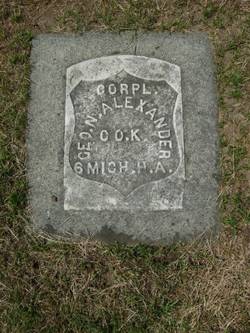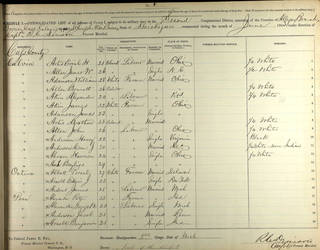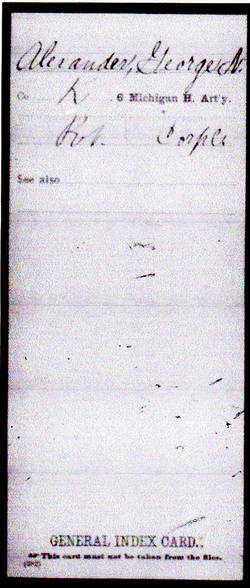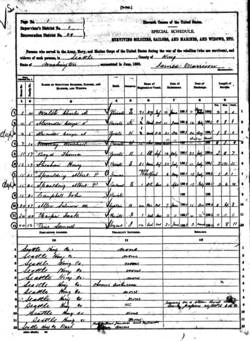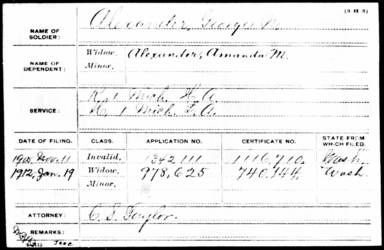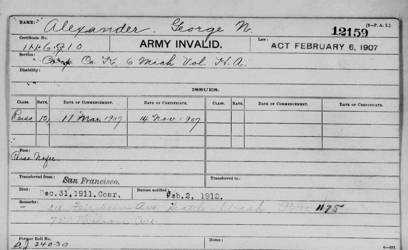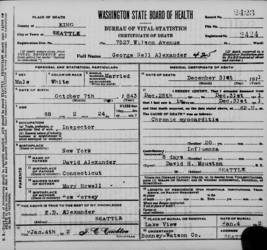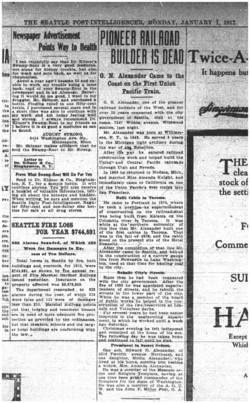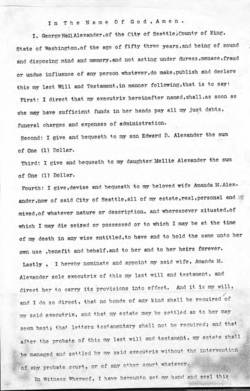George Nell Alexander
Representing: Union
G.A.R Post
- John F Miller Post #31 Seattle, King Co. WA
Unit History
- 1st Michigan Light Artillery Battery H
- 6th Michigan Infantry K
Full Unit History
1st MICHIGAN VOLUNTEER LIGHT ARTILLERY
Organized: Early, 1862 Monroe, MI
Mustered In: 3/6/1862 Monroe, MI
Discharged: 7/22/1865 Jackson, MI
6th MICHIGAN VOLUNTEER INFANTRY/HEAVY ARTILLERY
Organized: Summer, 1861 Kalamazoo, MI
Mustered In: 8/20/1861 Kalamazoo, MI
Mustered Out: 8/20/1865 New Orleans, LA
Regimental History
BATTERY HISTORY: (Batty. H)
During the American Civil War (ACW) infantry and cavalry regiments generally campaigned and fought as units. Such was not the case with artillery regiments. Artillery companies (batteries) of four to six guns were assigned to separate armies in the field so regiments seldom, if ever, came together as a whole. That being said, herein we are focusing on battery "H" rather than the 1st Michigan as an entity.
The 1st Michigan Light Artillery was a three year regiment. Its batteries served in both the eastern and western theaters of the ACW.
Battery "H" was organized in Monroe, MI during the early months of 1862. Its period of service was spent in the western theater of The War.
The battery left Michigan on 3/31`/1862 and proceeded to St. Louis, MO. From there it moved to New Madrid and took part in the siege of Island No. 10. From that time until the siege of Vicksburg, MS in May, 1863 the battery was scouting and skirmishing with the enemy in both Tennessee and Mississippi.
In 1863 Battery "H" fought the Rebels at Raymond, MS (5/12) and at Champion's Hill, MS (5/16). During the subsequent siege of Vicksburg it lost one killed and seven wounded. After the fall of the city (7/4) the battery was engaged in a number of expeditions in the surrounding countryside.
At Big Black River thirty six members of the battery re-enlisted. Thirty day furloughs followed.
1864. February found Battery "H” in Cairo, IL. From there it joined Union General W.T. Sherman's campaign to capture Atlanta, GA. During this period it had contact with the enemy in nearly all the prominent battles and the siege of the city itself. When General Sherman moved his army south of Atlanta the battery took a prominent part in the battle of Jonesboro which led to Atlanta's fall.
After the capture of Atlanta Battery "H" marched to Chattanooga, TN. From there, in November, it moved to Nashville where it remained until 2/1865 when it was ordered to Michigan, paid off and discharged.
BATTERY LOSSES:
Killed Or Mortally Wounded: 3; Died Of Disease, Accidents, Etc.: 30; Discharged because of wounds or disease: 63.
REGIMENTAL HISTORY: (6th)
The 6th was a three year regiment. It saw some active service in the eastern war theater, but spent a majority of its time in the west along the Mississippi River and Gulf of Mexico.
Organized as an infantry unit, the 6th left the state in 8/1861. It spent the winter of 1861/'62 in Baltimore, MD.
In 2/1862 the regiment sailed from Fortress Monroe, VA to New Orleans, LA arriving at the latter place after the city had fallen (5/1) into Union hands. On 8/5 it suffered severely in killed and wounded at Baton Rouge.
July, 1863 saw Union Gen. Banks change the designation of the 6th from infantry to heavy artillery. Thus, the regiment came to be recognized as both the "6th Infantry" and the "6th Heavy Artillery."
From May until July, 1863 the regiment was engaged in the siege of Port Hudson, LA. After the capture of that place the 6th remained there until 3/1864 when two hundred forty seven men re-enlisted and the unit headed home on furlough.
Thirty day furloughs having ended, the 6th returned to Port Hudson. It then moved to Vicksburg, MS where it served as engineers. Shortly thereafter the regiment was split up into detachments which sortied into Louisiana. There they were assigned to Ft. Morgan, Ft. Gaines, Dauphin Island and Mobile Bay.
As heavy artillerists the men of the 6th provided valuable service to the Union cause until 8/20/1865 when, at New Orleans, LA the unit was mustered out of Federal service. It then returned to Michigan. Arriving there on 8/28 it was paid off and discharged.
REGIMENTAL LOSSES:
Killed Or Mortally Wounded: 70; Died Of Disease, Accidents, Etc.: 432.
Soldier History
SOLDIER: (1st)
Residence: Lenawee County, WI Age: 18.8 yrs.
Enlisted/Enrolled: 6/11/1862 Hudson, MI Rank: Pvt.
Mustered In: 6/11/1862 Hudson, MI
Discharged For Disability: 1/8/1863 Columbus, OH
Highest Rank: Pvt.
Rank At Discharge: Pvt.
SOLDIER: (6th)
Residence: Inf. Not Avail. Age: 20.2 yrs.
Enlisted/Enrolled: 12/21/1863 Hudson, MI Rank: Pvt.
Mustered In: 1/5/1864
Mustered Out: 8/20/1865 New Orleans, LA
Highest Rank: Cprl.
Rank At Discharge: Cprl.
Family History
PERSONAL/FAMILY HISTORY:
NOTE: The birth - to - death biographical profile of George Alexander was created in September, 2021 during the Covid-19 medical pandemic. It contains less depth of detail than many other biographies within this website because military service, pension and other veteran-related files housed in Washington, D.C.'s National Archives were not available. At a later time those documents may be obtained and the data contained therein added to the narrative which follows.
______________________________________________________________________________________________
George Nell Alexander was born 10/7/1843. The location of his birth was within New York State.
Parenting George were David Alexander (b. 2/2/1811 CT - d. 1/1/1880 Hudson Lenawee County. MI) and Mary Ann (nee Howell b. 9/23/1820 NY - d. 7/8/1893 Hudson Lenawee County, MI) Alexander. David Alexander was a farmer.
Based on U.S. Census data, as best as can be determined George was the second eldest of four Alexander children. Older than he was Harriett Alexander (b. 1842 NY). Younger than he were Francis D. "Frank" Alexander (b. 5/20/1849 NY) and William P. Alexander (b. 1851 unk. - d. unk.).
In 1850 the Alexander family was farming in Williamson Wayne County, NY. A decade later, in 1860 they were tilling the soil in Rollins Lenawee County, MI.
It appears George remained on his parents' farm until 6/1862 when he enlisted in the U.S. Army. His regiment was the 1st Michigan Light Artillery. Within that organization he was a private soldier in Battery (Company) "H."
Private Alexander's period of enlistment was three years. He did not, however, fulfill the complete term. On 1/8/1863 he was granted a disability discharge. Without accessing his military service records the nature of his disability remains an unknown.
Whatever had been ailing George, he had sufficiently recovered from to re-enlist less than one year after his discharge. On 12/1/1863 he re-entered the army as a private in the 6th Michigan Infantry/Heavy Artillery. He was able to complete this enlistment and rose in rank as circa 11/15/1864 he was promoted to corporal.
Drawing upon information in George's Seattle Post - Intelligence newspaper obituary dated 1/1/1912, after leaving the military he entered the field of railroad construction. During this period he helped build the Union and Central Pacific railroads as they crossed Utah and Nevada.
Again, turning to his newspaper obituary, in 1869 George returned to Hudson, MI and married Amanda Mollie (nee Knight b. 12/19/1848 MI).* How and when the two had met are unknowns, but very likely they had known one another since they were youths. The date of the wedding is not known.
During their forty years together George and Amanda produced four children. Two of those children were living at the dawn of the twentieth century. Those two Alexander children were: Edward D. Alexander (b. 2/1880 WT) and Mollie K. Alexander (b. 1/1886 WT). Names of the other two children are not available within available documentation.
According to the U.S. Census for 1870, George and Amanda were residing in New York, York. His obituary, however, says he moved westward to Portland, OR in 1870. There he "took a position as superintendent of construction on the railroad that was being built from Kalama on the Columbia River to Tacoma (Washington Territory WT). It was while at the northern extremity of this line that Mr. Alexander built one of the first cabins in Tacoma. That was in the fall of 1870."
The obituary continues: "After the completion of that line (Northern Pacific Railroad), Mr. Alexander came to Seattle and helped in the construction of a Narrow Gauge (railroad) line from New Castle (in eastern King County) to Lake Washington, used at that time for hauling coal to the city (of Seattle).
In 1880 the Alexanders were in Fed (eral Way) King County, WA. That year no occupation was listed for George.
1883. The Alexanders were then residing in Renton King County, WA. George's occupation at that time was noted as being railroad clerk.
4/1885, 7/1887 and the year 1889 found the Alexanders in Seattle King County, WA. In '83 George's occupation was "engineer". In '87 it was "contractor" and, in 1889 it was railroad worker.
George’s “contractor" title likely referred to him building streets in the city of Seattle as, after completion of the narrow gauge coal railroad ,George had "become connected with (Seattle's) city government. Returning to his obituary: "After the fire of 1889 he (George) was appointed superintendent of streets and he rebuilt the streets in the lower part of the city. (Also,) while he was a member of the (Seattle) board of public works he helped in the construction of the reservoirs at Lincoln and Volunteer parks. He then became a building inspector.
In both 1900 and 1910 George and Amanda were residents of Seattle, proper. During that first year George listed his line of work as building inspector. In the latter he noted he was the Chief Inspector of the City Engineering Department.
As chief inspector in the Seattle Engineering Department, George worked up until Christmas Eve 1911. That evening he felt "indisposed" and remained at the Seattle home of son, Edward. The following day he was taken to his own home where his health continued to fail.
George Nell Alexander died on 12/31/1911. The cause of the sixty eight year old's passing is not known. Burial was/is in Seattle’s Lake View Cemetery located on the north end of Capitol Hill.
Interestingly, at the age of fifty three years George had created his last will and testament. In that document he left the bulk of his estate to Amanda. He bequeathed to Edward and Mollie one dollar each.
Dropping back a bit, on 11/9/1905 George had been granted a U.S. Government disability pension based on his days of Civil War soldiering. Although we know a monthly stipend was granted, without accessing his pension files the details of his payment receipts are not known.
On 1/19/1912, a scant few days following her husband's passing, Amanda petitioned the U.S. Government to continue receiving at least a portion of the old soldier's pension. Again, we known the request was granted, but details of Amanda's payments are not known.
Amanda died in Seattle King County, WA on 12/28/1916. She was/is buried in the Lake View Cemetery.
______________________________________________________________________________________________
* Some of this information courtesy of Denise Ottoson.
Cemetery
Buried at Lake View Cemetery Seattle
